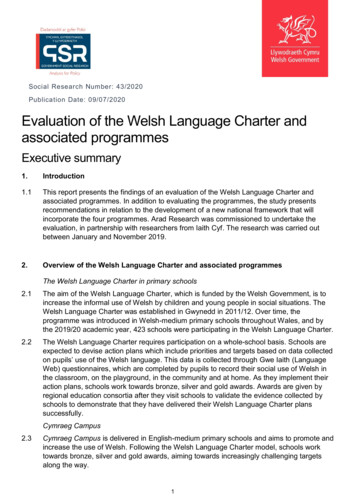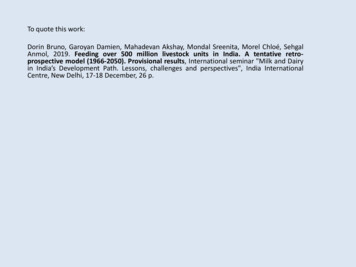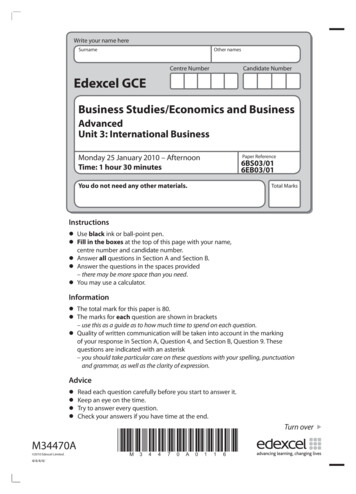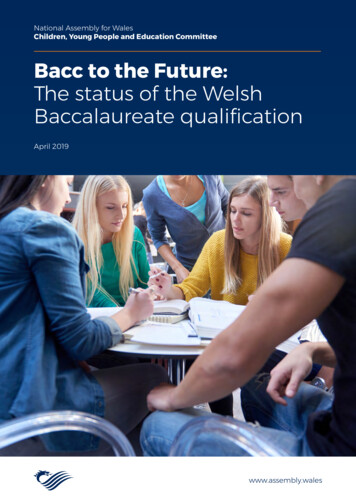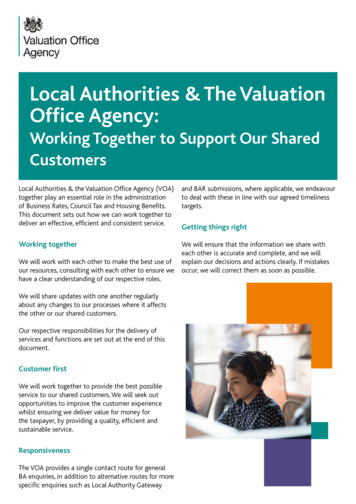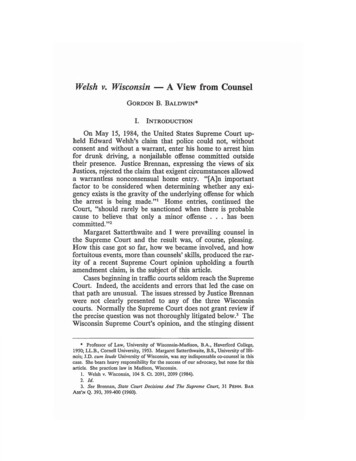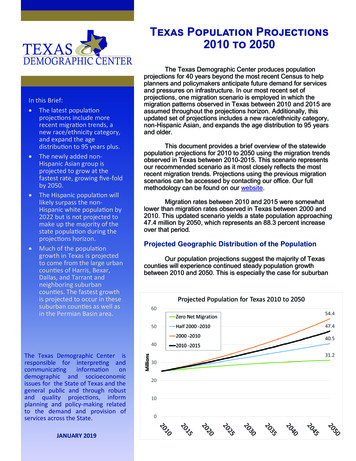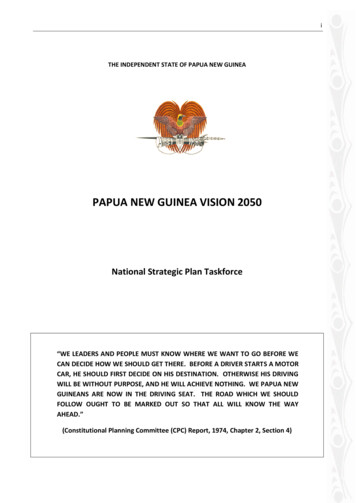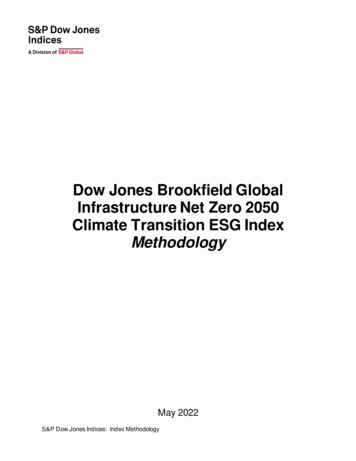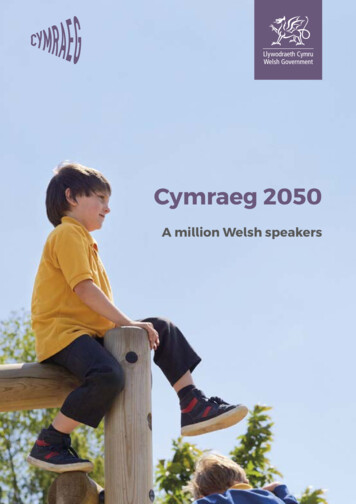
Transcription
Cymraeg 2050A million Welsh speakers
Cymraeg 2050: A million Welsh speakersAudienceWelsh Government departments; public bodies in Wales; third sector bodies inWales; private sector companies in Wales; educational organisations in Wales;organisations working to promote the use of Welsh; organisations working withfamilies, children and young people, and communities; and other interested parties.Action requiredInterested parties to note the content of the strategy and act accordingly.OverviewThis is the Welsh Ministers’ strategy for the promotion and facilitation of the useof the Welsh language. It has been prepared in accordance with Section 78 ofthe Government of Wales Act 2006. This strategy supersedes A living language:a language for living – Welsh Language Strategy 2012–17, and its associatedpolicy statement, A living language: a language for living – Moving forward. TheCymraeg 2050 Strategy sets out the Welsh Government’s long-term approach toachieving the target of a million Welsh speakers by 2050.Further informationEnquiries about this document should be directed to:Welsh Language DivisionWelsh GovernmentCathays ParkCardiffCF10 3NQe-mail: Cymraeg@gov.walesAdditional copiesThis document can be accessed from the Welsh Government’s websiteat gov.walesRelated documentsTaking Wales Forward 2016–2021 (2016); A living language: a language for living –Welsh Language Strategy 2012–17 (2012); A living language: a language for living –Moving forward (2014); Welsh Language (Wales) Measure 2011; Welsh-mediumEducation Strategy (2010)Mae’r ddogfen yma hefyd ar gael yn Gymraeg.This document is also available in Welsh. Crown copyright 2017WG31851Print ISBN 978 1 78859 035 8Digital ISBN 978 1 78859 033 4
ContentsMinisters’ foreword2VisionA million Welsh speakers by 2050Realising the visionContextA national strategyA long-term strategyOur targetsAchieving our targetsHow we will put the strategy into action4446711111213Conceptual basis and principlesLife-course approach1417Reaching a millionLanguage skills acquisitionProjection and trajectory to a millionThe assumptions that form the basis of the trajectoryLanguage use2020222627Three strategic themes28Theme 1: Increasing the number of Welsh speakers1. Language transmission in the family2. The early years3. Statutory education4. Post-compulsory education5. The education workforce, resources and qualifications313335374043Theme 2: Increasing the use of Welsh6. The workplace7. Services8. Social use of Welsh47495255Theme 3: Creating favourable conditions – infrastructureand context9. Community and economy10. Culture and media11. Wales and the wider world12. Digital technology13. Linguistic infrastructure14. Language planning15. Evaluation and research5961646770727577Conclusion79Bibliography80
2Ministers’ forewordA million Welsh speakers by 2050The Welsh language is one of the treasures of Wales. It is part ofwhat defines us as people and as a nation. Our ambition as WelshGovernment is to see the number of people able to enjoy speakingand using Welsh reach a million by 2050. This is certainly a challengingambition, but a challenge we believe is worthwhile and necessary if weare to secure the vitality of the language for future generations.The starting point for this strategy marks the fiftieth anniversary of thefirst Welsh Language Act in 1967. We now live in different times and thestatus of Welsh is enshrined in legislation made in Wales.The 2011 Census results presented us with an opportunity to have frankconversations and re-evaluate the future that we want to see for thelanguage. Things need to change. We need to renew our energy, besystematic in our approach to planning, and improve collaboration inorder to secure the legacy our language deserves.We are very clear that it is our responsibility as a Government to set thedirection and provide leadership for this work. This Government hasthe will and the commitment to do so. But it is also vital that we as anation take ownership of the challenge. Government cannot insist thatparents and carers use the Welsh language with their children, thatchildren play together in Welsh or that someone uses Welsh socially.We can, however, work to provide the conditions to facilitate anincrease in the number of Welsh speakers and an increase in the useof Welsh.Education is central to our vision, but we must ensure our youngpeople come out of the education system ready and proud to use thelanguage in all contexts. Without a doubt, digital technologies will becentral to the vision within education, helping workplaces becomebilingual and supporting social use.The overarching message in this document is that we need to reacha position where the Welsh language is an integral element of allaspects of everyday life. If we want to achieve this, the whole nationhas to be part of the journey – fluent Welsh speakers, Welsh speakerswho are reluctant to use the language, new speakers who have learned
3the language, and also those who do not consider themselves to beWelsh speakers. Everyone has a part to play, and we want everyone tocontribute to realising our ambition.By raising our expectations and adopting an ambitious vision we havethe potential to change the future outlook for the language. Together,we can enable the Welsh language to grow, and create a truly bilingualWales with a living language for all.Rt. Hon Carwyn Jones AMFirst MinisterAlun Davies AMMinister for Lifelong Learningand Welsh Language
4VisionA million Welsh speakers by 2050The year 2050: The Welsh language is thriving, the number ofspeakers has reached a million, and it is used in every aspect of life.Among those who do not speak Welsh there is goodwill and a senseof ownership towards the language and a recognition by all of itscontribution to the culture, society and economy of Wales.Realising the visionThe challenge of achieving a million Welsh speakers by 2050 calls forfar-reaching changes. Boundaries need to be pushed and ambitiousaction taken to enable more people to learn and use Welsh. Thisstrategy builds on existing foundations and moves us on to the nextstage in our language journey. We have identified three strategicthemes to achieve this vision.1. Increasing the number of Welsh speakers2. Increasing the use of Welsh3. Creating favourable conditions – infrastructure and contextIn order to realise the vision, we will need to take action under thethree themes and also understand the interdependenciesbetween them.
5Theme 1:Increasing thenumber of Welshspeakers Language transmission inthe family The early years Statutory education Post-compulsory education The education workforce,resources and qualificationsTheme 2:Increasing the useof Welsh The workplace Services Social use of WelshTheme 3:Creating favourable conditions – infrastructure and context Community and economyCulture and mediaWales and the wider worldDigital technology Linguistic infrastructure Language planning Evaluation and research
6ContextThis strategy is not the beginning of the journey. Considerable progresshas been achieved through Government support for the Welshlanguage over the last quarter of a century.The Welsh language now has official status; legislation is in placewhich provides rights for Welsh speakers to receive Welsh-languageservices, and a Welsh Language Commissioner has been appointed tooversee the implementation of these rights. Through the Well-being ofFuture Generations Act (Wales) 2015 specified public bodies coveringthe whole of Wales are required to work towards seven well-beinggoals, one of which is ‘A Wales of vibrant culture and thriving Welshlanguage’; and the system for planning Welsh-medium educationprovision also has a statutory basis. Welsh Government is under a dutyto promote and facilitate the use of Welsh and work towards thewell-being goals.In September 2016 we published Taking Wales Forward 2016–2021,the Welsh Government’s programme for the next five years. It sets outthe Government’s programme to drive improvement in the Welsheconomy and public services, delivering a Wales which is prosperousand secure, healthy and active, ambitious and learning, united andconnected. Taking Wales Forward 2016–2021 outlines this Government’spriorities for delivering those improvements. They are ambitiousmeasures, aimed at making a difference for everyone, at every stage intheir lives.Within this strategy we set out our ambition for the Welsh languageto be used more extensively and for the number who speak it to grow.We also set out our commitment to work towards one million peoplespeaking the Welsh language by 2050 and to continue to invest inencouraging more people to use and speak Welsh in their daily lives.Alongside our programme Taking Wales Forward 2016–2021, we havepublished well-being objectives which set out how we will use theWell-being of Future Generations Act (Wales) 2015 to help deliver ourprogramme for government and maximise our contribution to theseven shared national well-being goals.
7A national strategyThis is a strategy for the whole of Wales, and we want every part ofthe country to share in the vision of a million Welsh speakers. Thereis potential for growth in the number of Welsh speakers, particularlyin areas of Wales that have high population density but lowerpercentages of Welsh speakers. At the same time we need to ensurethe future vitality of Welsh-speaking communities as places thatfacilitate the use of the language in every aspect of life.Our vision is to secure favourable circumstances throughout thecountry that support language acquisition and use of Welsh languageskills. We want to see an increase in language transmission in thefamily, early introduction of Welsh to every child, an education systemthat provides Welsh language skills for all, and greater appreciationof Welsh language skills in the workplace. At the same time, we arecommitted to supporting people to use Welsh socially, at work, andwhen accessing services.This means considering each area of Wales on the basis of its ownlinguistic composition, and planning in order to strike the appropriatebalance locally. For example, in Welsh-speaking communities,the challenge is to ensure that people have good quality jobs,fulfilling careers and homes so that they can stay, or return to thosecommunities. In other areas, promoting the use of Welsh as a languagefor the workplace and business will become increasingly important.The Welsh language must be part of the digital revolution, which spansthe three themes of this strategy. We must ensure that high-qualityWelsh language technology becomes available during the early stages ofthis strategy to support education, workplaces and social use of Welsh.
8Proportion of people (aged 3 and over) able to speak Welsh,by LSOA, 2011Isle ofAngleseyFlintshireConwyDenbighshireLocal AuthorityWrexhamGwynedd% able to speak Welsh10% or less (645)Between 10% and 30% (942)Between 30% and 50% (142)PowysBetween 50% and 70% BlaenauTydfilGwentMonmouthshireNeathPort TalbotRhonddaCynonTafSwanseaidgBrSource: 2011 Census193.12-13Geography & Technology Crown Copyright and database right 2013. All rights reserved.Welsh Government. Licence number 100021874.eCaerphillyndCardiffVale ofGlamorganTorfaenOver 70% (49)Newport
9Change in the proportion of people able to speak Welsh,by LSOA, 2001 to 2011 (a)
10Number able to speak Welsh by community, 2011
11A long-term strategySetting a long-term target reflects the fact that activity aimed atincreasing the number of speakers does not happen overnight:language planning is a long-term endeavour. This approach allows usto consider the bigger picture, and to concentrate on the truly strategicchanges which will make the greatest difference to the language overthree decades.However, while this is a long-term vision, and the number of speakers issomething that can only be measured meaningfully every decade, wehave to take action and lay the foundations now. These actions mustreflect the scale of our ambition.The initial years of this strategy will focus on laying the foundations tofacilitate an increase in the number of Welsh speakers in the longer term.Our targetsAs well as achieving a million Welsh speakers by 2050, we are clear thatthe success of this strategy must also be judged in terms of levels ofWelsh language use. The overarching targets for this strategy areas follows. The number of Welsh speakers to reach 1 million by 2050. The percentage of the population that speak Welsh daily, and canspeak more than just a few words of Welsh, to increase from10 per cent (in 2013–15) to 20 per cent by 2050.The target of a million speakers by 2050 leads inevitably to thequestion of what defines a ‘speaker’, that is, how competent someoneshould be before being considered a ‘Welsh speaker’. Our starting pointis the census figures, which are derived from a self-assessment of Welshlanguage skills. According to the most recent census in 2011, there were562,000 Welsh speakers in Wales1.A number of factors are likely to influence how individuals assessthemselves and other family members in terms of their language skills(for example their linguistic points of reference or how they measuretheir ability against the skills of others they know, or the extent towhich their motivation or aspirations prompt them to value their skillsin Welsh). Our aim through this strategy is to create the conditionswhereby everyone in Wales will have access to the Welsh language,and that every speaker, regardless of their level of ability, will be able tochoose to use their Welsh language skills and receive encouragementand support to further develop their skills if they so wish, in an inclusiveand positive environment.1The census asked respondents in Wales if they were able to understand spoken Welsh, speak Welsh,read Welsh or write Welsh (or if they had no ability in Welsh).
12Achieving our targetsTo achieve our targets, we will drive the following transformationalchanges. Successful implementation will be dependent on a numberof organisations working together. Make rapid progress to expand Welsh-medium early yearsprovision by 150 nursery groups over the next decadeto facilitate a seamless transition into Welsh-mediumeducation. Increase the proportion of each school year group receivingWelsh-medium education from 22 per cent (based on 7,700seven-year-old learners in 2015/16) to 30 per cent (about10,500 in each year group) by 2031, and then 40 per cent(about 14,000 in each year group) by 2050. Transform how we teach Welsh to all learners in order that atleast 70 per cent of those learners report by 2050 that theycan speak Welsh by the time they leave school. Increase the number of primary teachers who can teachin Welsh from 2,900 to 3,900 by 2031 and 5,200 by 2050;increase the number of secondary teachers who can teachWelsh from 500 to 900 by 2031 and 1,200 by 2050; andincrease the number of secondary teachers who can teachthrough the medium of Welsh from 1,800 to 3,200 by 2031and 4,200 by 2050. Reform the post-16 Welsh-medium and bilingual educationand skills offer to ensure that young people have theopportunity to continue developing bilingual skills tosupport a prosperous economy. Review the legislation which underpins the Welsh languageto ensure it offers a strong foundation for promoting andfacilitating the use of Welsh. Ensure that Welsh Government leads by example bypromoting and facilitating increased use of Welsh by ourown workforce. Develop a new regional focus to economic developmentto help all parts of Wales to benefit from prosperity andsupport each area to develop its own distinctive identity. Transform the Welsh language digital landscape withparticular focus on language technologies. Develop a national programme to increase understanding ofbilingualism.
13How we will put the strategy into actionIn order to realise our vision, we will: provide strong leadership, and use our influence for the benefit ofthe language provide financial support to promote and facilitate the use of Welsh legislate to provide a strong infrastructure for the language lead by example in our use of and approach towards the Welshlanguage.The successful implementation of the strategy will require an appropriatebalance between efforts to promote and facilitate the use of Welsh in apositive and inclusive manner, a drive to improve systematic planning ofWelsh-language provision, and a robust regulatory framework.We will publish work programmes at regular intervals which will detailwhat action is required to achieve our goal. The first of these workprogrammes for 2017–21 is published alongside this strategy.We will continuously monitor and evaluate the implementation ofthis strategy to ensure that the transformational changes requiredare delivered. Indicators 36 and 37 of the National Indicators for Waleswill be used to track progress against the national well-being goal andtowards the two overarching targets of this strategy. The indicators areas follows: Well-being indicator 36: Percentage of people who speak Welshdaily and can speak more than just a few words of Welsh. Well-being indicator 37: Percentage of people who can speak Welsh.As we implement this strategy, we will follow some basic principles.These are outlined over the next pages.
14Conceptual basis and principlesIn order to reach a situation by 2050 where there are a million Welshspeakers and increased use of Welsh language skills, concerted actionis required now and in the future to: increase the number of Welsh speakers increase and widen opportunities for them to use their skills create an environment where everyone will want to use theWelsh language.Language use and language behaviour are conditioned by a varietyof interdependent factors. The theoretical model for languagerevitalisation proposed by Joshua Fishman, and subsequentapproaches that have sought to illustrate the multi-dimensional natureof language behaviour, have provided a basis for understanding thedynamics of language use (Grin and Moring 2002; Darquennes 2007)2.Miquel Strubell (Strubell 2011) introduced his Catherine Wheel modelto demonstrate the interrelationship between: language learningdemand for and supply of goods and services in the languageconsumption of goods and services in the languageperception of usefulness of the languagemotivation to learn and use the language.The fundamental principle introduced by Strubell is that the vitalityof a language hinges on the interaction between a number ofinterdependent elements which generate growth. The wheel is anattempt to illustrate the interdependency between these components.Despite the limitations associated with a schematic model of this kind,the wheel continues to provide a useful starting point as we develop asustainable infrastructure for the Welsh language.At the same time, creating and implementing a strategy for the Welshlanguage in the year 2050 requires an understanding of how speakersuse the Welsh language today, and a consideration of how they arelikely to do so in future. We must be prepared to adapt our languageplanning policy methods to reflect the social, economic and politicalchanges that shape, and which will continue to shape, contemporaryWales. We do not have a detailed picture of how people will be living2See the Welsh Language Strategy Evaluation /welsh-language-strategy-evaluation/?skip 1&lang en)
15their lives by the year 2050, but in all probability the developmentswitnessed in recent decades will continue to transform oureveryday lives. We see how globalisation, mobility, and more variedinterpretations of concepts such as the family unit and ‘community’have led to far-reaching changes. We also see how developmentsin technology offer new ways of carrying out our work andcommunicating with each other. At the same time, these changes havenot replaced the importance of communities which are defined bygeography, social networks based on face-to-face communication, andthe key role of households as the focus of family life.As we develop our long-term programme for the Welsh language,therefore, our aim is to ensure that our language planning objectivesand approaches demonstrate an understanding of how speakers uselanguage in the wider context of how they interact and relate toeach other.Sociolinguistic research has focused increasingly during the last twodecades on how speakers use their linguistic resources – and definetheir linguistic identities – in a variety of networks and environmentswhere the boundaries are often fluid (Heller 2011, Pennycook 2010;Pietikäinen 2013; Martin-Jones and Martin 2017). This interpretationof speakers as users of a range of different language resources, andas participants in a variety of networks and communities of speakers,
16raises a number of key questions regarding our vision for the Welshlanguage as a vibrant language, equally viable in close-knit ruralcommunities, dispersed social networks in urban settings, and invirtual communities reaching across geographical spaces.Viewing speakers as participants in a variety of different networksalso raises questions about our understanding of concepts such as‘communities’ and ‘neighbourhoods’. Our vision for a sustainablegrowth in the number of Welsh speakers recognises the keycontribution of communities and social networks bound by placeand face-to-face interaction. We recognise and value the role ofthese communities in providing a social context for the use of Welsh.However, supporting the vitality of geographical communities withhigh densities of Welsh speakers is one important element in acomplex picture. People live their lives based on a number of differentsocial factors, with current trends pulling people in several directions.As the patterns defining our day-to-day interactions continue tochange, and in view of the likelihood that these will continue toevolve during the lifespan of the strategy, we need to ensure thatour understanding of what constitutes ‘communities’, communitiesof practice and networks of speakers also continues to expand. Weforesee that the places where people spend a large proportion of theirtime, including workplaces, interest clubs, new social venues, andelectronic networks of all kinds, will become increasingly important.Our language planning must be sufficiently robust and flexible torespond to these trends.Areas with a high density of Welsh speakers remain central to ourvision. These are the places in Wales which create the most favourablecircumstances to foster Welsh speakers: the higher the number ofspeakers living in a geographical area, the higher the probability ofopportunities being available to them to use the language inday-to-day communication. These are also the places which have thehighest number of fluent Welsh speakers.These areas tend to be characterised by the fact that they are rural innature, with economies that currently depend largely on the publicsector, agriculture and tourism, with towns acting as centres servingwide areas for services and employment.There is no easy answer to the challenges facing these communities.However, we are clear about the need for language planning andeconomic development to work in tandem in order to createWelsh-speaking communities that are economically andlinguistically viable.
17Some areas with a lower percentage of Welsh speakers have seen anincrease in the number of Welsh speakers over recent years, followingthe growth of Welsh-medium education, and mobility trends whichsee people moving from rural areas to urban areas – and from thenorth and west to the south-east. This has led to the strengtheningof the language in some areas, bringing Welsh language capacity tothe workplaces and the economy of the south, which in itself is slowlyenhancing the status of the language.The challenge in these areas, where Welsh is heard less often thanin areas of higher percentages of Welsh speakers, is to expand theopportunities for people to be able to use the language in their daily life.Life-course approachThis strategy recognises the key contribution of language transmissionin the home to the future vitality of the Welsh language. However, wealso acknowledge that we cannot ensure an increase in the number ofspeakers on the required scale by increasing transmission rates alone.The contribution of speakers who acquire Welsh outside the home isvital to the success of our strategy. Creating the right conditions for newlearners of all ages to develop and use their skills is a key objective –from the early years, through every stage of compulsory education andpost-16 provision, to opportunities for adults to learn Welsh.Recent research on new speakers provides valuable insights into theexperiences and trajectories of those who acquire language througheducation or some form of learning, rather than through home orcommunity exposure to the language (O’Rourke, Pujolar et al. 2015).Specifically, the concept of mudes, or ‘adaptations to languagebehaviour’, provides a useful basis for understanding how peopledevelop their language skills and practices over their lifetime (Pujolarand Puigdevall 2015). Our focus in this strategy is on how opportunitiesfor individuals to acquire or learn Welsh, and how opportunities touse the language, build up a narrative over time. We also need toremember that individuals’ linguistic journeys do not necessarily followa systematic linear pattern, and that they interrelate with a variety ofsocial factors.This focus on the accumulation of experiences over time, and on theconnections between individual trajectories and the social contextthat shapes them, draws on the principles underpinning thelife-course approach. While life-course models have largely beenapplied in areas such as public health, ageing and socioeconomic
18outcomes (Billari 2001; Ben-Shlomo and Kuh 2002; Mayer 2009), theunderlying concepts are in many ways relevant to language planningpolicy. The following elements of the life-course approach areparticularly relevant: the influence of historical and geographical contexts on people’sexperiences and opportunities identifying key ‘transition phases’ acknowledging variations in the way in which different individualsrespond to circumstances interrelationship between individuals and their families and theirnetworks of relations how the past shapes the future, i.e. long-term perspective, and thecumulative effect of experiences individuals as active players who can make decisions and choices,and set objectives for their own actions.Another feature of the life-course approach which merits attentionis that relating to the element of risk – either through ‘critical points’where specific risks could lead to ongoing negative changes, or asindividuals encounter risks over time, with the cumulative effect ofthese outcomes leading to negative situations or outcomes.
19In the context of acquiring, using and sharing Welsh with others, thisentails purposeful planning in order to ensure that the best possibleconditions are in place to: support speakers as they begin to develop their linguistic skills – athome, through the education system or later in life facilitating their ability and their readiness to continue to use Welsh,with their families, in their communities and social networks, withtheir colleagues and in accessing services identifying the circumstances and factors most likely to weakentheir contact with the language or diminish their readiness to use it equip speakers to make decisions that will support their use ofWelsh in future.The challenge for us as a Government is to gain a better understandingof the way in which people use the language, influence the decisionsthey make at key points in their lives (for example when moving fromeducation to the workplace, or becoming parents for the first time),and facilitate situations and spaces which make it easier for people touse the language.
20Reaching a millionReaching a million Welsh speakers by 2050 would reverse the declinein the number of speakers over the twentieth century: in 1911, therewere almost a million (977,000) Welsh speakers aged three and overin Wales.The chart below shows the progress of the language over the lastcentury. Based on the 2011 Census figures, approximately 438,000 newWelsh speakers are needed by 2050 if we are to reach a million. Thismeans not only taking action to increase the number of speakers, butalso sustaining existing numbers, since mortality and out-migrationwill affect the current number of speakers.Number of Welsh speakers aged 3 and overChart 1: Number of people aged three and over able to speak Welsh,1911–2011 Census, together with the ambition by 001911 1921 1931 1941 1951 1961 1971 1981 1991 2001 2011 2021 2031 2041 2051YearLanguage skills acquisitionThe aim of achieving a million speakers means developing furtherthe methods which are most likely to lead to the necessary increase.There are two main methods, namely transmitting the Welsh languagefrom one generation to the next, and developing and sustaining skillsthrough education and training.3Note that there was no census in 1941.
21Language transmission in the familyThe 2011 Census reported that in couple households where two adultscould speak Welsh, 82 per cent of children between three and fouryears of age were also able to speak Welsh. In couple households whereone adult could speak Welsh, 45 per cent of children three to four yearsof age were able to speak Welsh. Encouraging more parents/carers totransmit the language to their children is a key priority for this strategy.Nevertheless, there is a limit to the additional number of Welshspeakers that can be created by transmitting the language from o
the Government of Wales Act 2006. This strategy supersedes A living language: a language for living - Welsh Language Strategy 2012-17, and its associated policy statement, A living language: a language for living - Moving forward. The Cymraeg 2050 Strategy sets out the Welsh Government's long-term approach to
